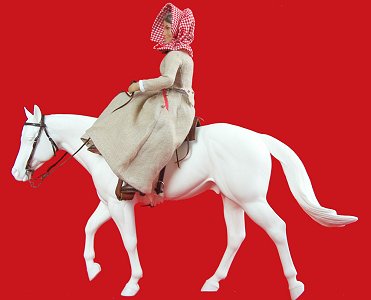|
NAMHSA 15th Anniversary Party - Lot #22
 (model NOT included) Goodnight Says Hello!
(click image to open larger view in a new tab)
(more images below description)
Goodnight Says Hello!
A Victorian-style Traditional scale tack and rider set depicting Molly Goodnight (wife of Charles Goodnight, Texas rancher and inventor of the first true Western side-saddle) by Keren Gilfoyle-McGroarty of !o-mi! miniatures.
The set comprises a full-articulated OOAK portrait doll of Molly Goodnight and the saddle her husband designed for her (plus extras). Molly looked after the huge ranch more or less by herself when her husband and the ranch hands were involved in their epic cattle drives, taking stock to the railhead. Molly has been recreated wearing a hand-sewn Eastern-style sidesaddle habit in linen over a habit shirt, as commonly worn during hot weather by women of all types (even in the west) who rode aside at this period. On her head she wears a red checked cotton sunbonnet to protect her face from sunburn and to keep the dust of the hard-baked prairie out of her hair. Her hands are clothed in real leather gloves on her feet in real hand-made leather boots. She has been rewigged with a salt-and-pepper blend of hair to reflect her mature years.
The saddle is a scale copy of the actual first Goodnight saddle (as the style came to be called): sturdy and workman-like enough for ranch riding, but with decorative border work. It features two cinches, fastened diagonally across the horse's belly in an 'X' shape to secure the saddle and balance it. The saddle is entirely handbuilt by Keren, right from the OOAK tree through the hand-dyed fine tooling calf body to the cinches themselves. A scale miniature hand-woven Mexican serape is included as a saddle blanket.
The set also includes a simple but sturdy working western bridle. Horse not included.
Two extra items are included to give the piece extra versatility: a modern western hat and decorative suede vest allow the purchaser to show Molly and her saddle in contemporary western events as well as in historic or costume classes.
 |
Last updated on June 30, 2010
|




